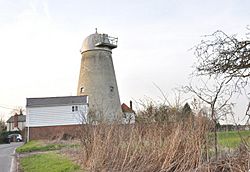White Roding Windmill facts for kids
Quick facts for kids White Roding Mill |
|
|---|---|

The mill in 2009
|
|
| Origin | |
| Mill name | White Roding Mill |
| Coordinates | 51°47′40″N 0°16′01″E / 51.794487°N 0.266881°E |
| Operator(s) | Private |
| Year built | 1877 |
| Information | |
| Purpose | Corn mill |
| Type | Tower mill |
| Storeys | Five storeys |
| No. of sails | Four sails |
| Type of sails | Patent sails |
| Windshaft | Cast iron |
| Winding | Fantail |
| Fantail blades | Six Blades |
| Auxiliary power | Engine |
| No. of pairs of millstones | Two pairs |
White Roding Windmill is a special old building in Essex, England. It is a Grade II listed building, which means it's important and protected. This type of windmill is called a tower mill. It used to grind corn into flour, helping people make bread and other foods.
Contents
The Mill's Story: A Look Back in Time
Building the Windmill
The White Roding Windmill was built in 1877. It replaced an even older windmill called a post mill, which had been on the same spot since 1609. Sadly, the old post mill was destroyed in a big storm on January 1, 1877. Its main support beam broke because the miller had too much canvas on the sails during the strong winds.
Who Built It?
After the old mill was destroyed, a new tower mill was built. It was made by a company called Whitmore's, who were expert millwrights from Wickham Market, Suffolk. Millwrights are people who design, build, and repair windmills.
When the Mill Stopped Working
The new tower mill worked using wind power until 1926. After that, it used an engine to grind corn until 1931. The people who were renting the mill decided not to continue in 1931, so the mill stopped working.
New Owners and Repairs
In 1937, a famous actor named Michael Redgrave bought the mill. Later, in 1946, a company in Barrow-in-Furness took ownership. During the 1950s, the mill was in bad shape and almost torn down several times. But in the 1970s, two skilled millwrights, Philip Barrett-Lennard and Vincent Pargeter, built a brand new top (called a cap) for the mill, helping to save it.
What the Windmill Looks Like Inside and Out
How the Mill is Built
White Roding Windmill is a five-story building made of brick. It has a special curved top, called an ogee cap. This cap could turn to face the wind, thanks to a six-bladed fantail at the back.
The Sails and Machinery
The mill had four large sails, known as Patent sails. These sails were attached to a strong cast iron shaft called a windshaft. This shaft would spin when the wind pushed the sails. Inside, the only part of the original machinery that is left is a huge gear called the Brake Wheel. It is about 9 feet 3 inches (2.8 meters) wide and has 115 teeth! Most of the other machinery was taken out shortly after the Second World War.
Size of the Windmill
The tower of the windmill is about 42 feet (12.8 meters) tall. At its base, it is about 22 feet 6 inches (6.8 meters) wide, and it narrows to about 13 feet 6 inches (4.1 meters) wide at the top. The walls at the bottom are very thick, about 26 inches (66 centimeters). The very top of the cap is about 50 feet (15.2 meters) high. This mill used to power two pairs of millstones that ground the corn from underneath.
People Who Worked at the Mill
Here are some of the millers who worked at White Roding Windmill over the years:
- George Wilson (1830–1839) - He worked at the old post mill.
- William Portway (1845–1848)
- John Dixon (1850)
- Benjamin Roast (1855–1877) - He worked at the old post mill.
- Benjamin Roast (1877–1890) - He then worked at the new tower mill.
- William and Frank Roast (1890–1917)
- William Garner and Sons (1917 - 1936)

